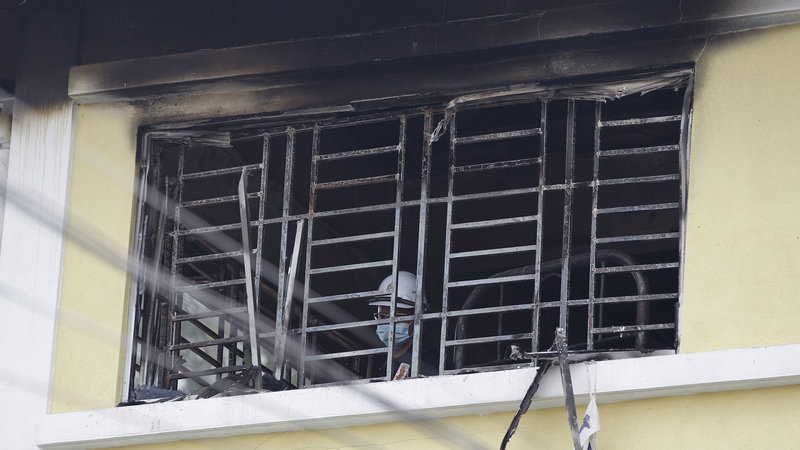 Security bars and grilles are common on windows in many developing countries and in other areas where security is a major concern. Unfortunately it is also common for those security methods to prevent emergency egress and contribute to loss of life when a fire occurs. This is an example of the unintended consequences that can occur when security needs are addressed without considering life safety.
Security bars and grilles are common on windows in many developing countries and in other areas where security is a major concern. Unfortunately it is also common for those security methods to prevent emergency egress and contribute to loss of life when a fire occurs. This is an example of the unintended consequences that can occur when security needs are addressed without considering life safety.
The International Building Code (IBC) requires emergency escape and rescue openings to be operational from inside of the room without keys or tools, and without force greater than what is required for normal operation of the window. Buildings with security bars or grilles on the windows must be equipped with smoke alarms.
Without the protection provided by the codes and enforcement by code officials, the use of security bars and grilles can have tragic results. Last week, 21 students and 2 adults were killed in a fire in Malaysia, where dormitory windows were equipped with security bars. Here are a few of the news stories about this tragedy, including some thoughts from NFPA about security vs. safety:
~~~
Harsh Lessons from Fire – New Straits Times
The public who watched the news of the fire in the electronic media or read about it in the print or social media could see the permanently-fixed window grille at the top floor of the building which had prevented its occupants from escaping. According to reports, the building had one fire exit only on the third floor (where the fire started).
~~~
7 arrested in connection with Malaysia school fire that killed 21 students – CNN
Witnesses reported being awoken Thursday by cries for help from inside the burning building, where children appeared trapped by metal window grills.
“I saw children kicking on the grill, but they couldn’t get out. My friends and I rushed over and tried to reach them, but we couldn’t get in,” Shahirman Shahril told CNN.
When emergency responders arrived, “almost 90% of the building was already on fire,” a fire and rescue department official told reporters.
“The firemen could hear cries for help from inside the building,” spokesman Soiman Jahid said. “The first team from (the) fire station managed to save five of the children from the lower level.”
~~~
Deadly school fire in Malaysia brings issue of security versus safety back to the forefront – NFPA Xchange
This spring, NFPA Fire Protection Engineer Greg Harrington told NFPA Journal, “Ensuring that egress doors are not compromised must be the top priority. Don’t be misled into thinking that security takes precedence over life safety.” An exception to the rule is detention facilities, but the buildings in Malaysian and Guatemala were not classified as such.
~~~
We must not allow life safety to be overlooked in the rush to provide security. Life safety is everyone’s responsibility.
You need to login or register to bookmark/favorite this content.





I see the same issues in reverse. Many facilities have specialty hardware that is only openable when the fire alarm is activated. This goes against the grain when active shooters are on the site. Occupants can be cornered when following exit signs to a door that operates with security cards and/or alarm.
Hi Dan –
There are limited applications where hardware is only openable when the fire alarm is activated. Delayed egress locks are one possibility, but they release after 15 seconds when someone attempts to exit (when the fire alarm is not sounding). Controlled egress is another option but is only allowed in certain types of health care units.
– Lori
Every time I see those bars on windows it sends a chill down my spine. We just had 2 deaths outside of Miami last month. Here is an article about it http://wsvn.com/news/local/2-elderly-women-killed-in-hialeah-house-fire/ . So said and preventable.
The problem I see with door hardware in relation/code requirement of fire doors & paths of egress (IE fail safe hardware in the path of egress) is it’s not tested during fire alarm testing. I’m not that familiar with NFPA 72, but I’ve seen first hand fire alarm inspectors completely miss (Or not looking for) egress requirements for many years (which I’m currently in the process of correcting and working towards a better fire alarm testing contract that includes means of egress testing. If any one can point out where in NFPA 72 the requirement is to test “means of egress” during a fire alarm activation, It would be greatly appreciated).
The top level management people care about these topics before they provide funding, in this order (IMO) Convenience -> Security -> Fire/Life Safety. When in fact the order of importance is reversed. Perfect example why people with MBA’s should consider a 2nd opinion before bars, chains, double sided deadbolts, slide bolts,….. we know the list goes on, but the creativity of saving a buck is never surprising. My 2c